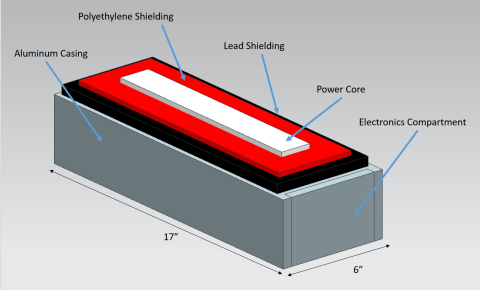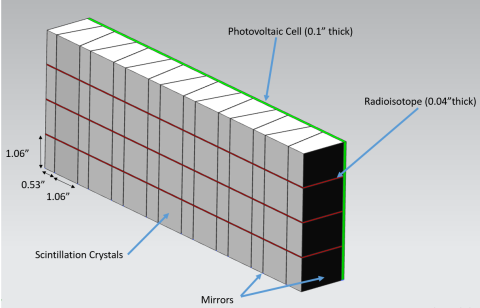The goal of this research is to design a radioisotope powered battery that is able to charge a cellular device when the owner is in need. This project resulted in a device powered by the beta decay of Sr-90. The beta particles interact with the scintillation material to create photons. These photons are channeled to an amorphous silicon photovoltaic cell located at either end of the trapezoidal, mirrored channels. The photons interact with the materials in the photovoltaic cell, releasing electrons. The electrons are attracted to the electrodes in the cell, which drives a current, this is then converted to usable energy by a circuit board. The goal is to produce a portable battery, so the device is designed to fit inside a standard backpack and it should weigh a maximum of 50 lbs. It must also meet the NRC standards by only exposing members of the general public to a maximum of 1 mSv/yr. The device should last a minimum of 50 years, so it will never need to be replaced during the lifetime of a homeowner. It will also be temperature resistant and waterproof to withstand natural disasters.
Team: Levi Kelly, Amalie Wendelken, Sydney Maurer, and Guangzhao Li
Project Motivation
Natural disasters are an inescapable reality on earth; this could take the form of an earthquake, a hurricane, a blizzard, or a wildfire. The best ways to combat these natural disasters are strong preventative measures and rescue protocols. The number of power outages is increasing, many of which are the result of natural disasters. In such situations, communication is key to immediate assistance. Phone lines and towers are often out of service, vehicles can be crushed or submerged, and effective communication radios are not common in most households. Most families in the United States own at least one cellular phone which can be used to call for assistance. Even with phone lines down, there are smartphone applications that convert the phone into a radio to coordinate with rescue efforts. Additionally, most cellular devices come equipped with a flashlight that would provide a light source for someone in need. Unfortunately, phones do not have limitless power so the device must be charged after a day’s worth of use. During a power outage, this becomes a problem. Some households own a backup generator, but these do not work if submerged or after the fuel is consumed. The only power source left is a battery charger or storage device but the shelf life of a standard alkaline battery is about 10 years and they only last 25 hours while being used.

CAD Model of Shielding Design
Project Description
The goal of this research is to design a radioisotope powered battery that is able to charge a cellular device when the owner is in need. This project resulted in a device powered by the beta decay of Sr-90. The beta particles interact with the scintillation material to create photons. These photons are channeled to an amorphous silicon photovoltaic cell located at either end of the trapezoidal, mirrored channels. The photons interact with the materials in the photovoltaic cell, releasing electrons. The electrons are attracted to the electrodes in the cell, which drives a current, this is then converted to usable energy by a circuit board. The goal is to produce a portable battery, so the device is designed to fit inside a standard backpack and it should weigh a maximum of 50 lbs. It must also meet the NRC standards by only exposing members of the general public to a maximum of 1 mSv/yr. The device should last a minimum of 50 years, so it will never need to be replaced during the lifetime of a homeowner. It will also be temperature resistant and waterproof to withstand natural disasters.

CAD Model of Power Core
Results and Accomplishments
This design has never been created on this large of a scale but there is ongoing research in this field. Extensive research and calculations were used to create a viable, innovative final design for this product. The subsystems of radioisotope, scintillator, geometry, photovoltaic cell, circuitry, shielding, and waterproofing were addressed throughout the project, ending in a CAD design of both the internal power cell and the general layout of the device. The design meets a majority of the technical specifications and proves that producing a radioisotope powered battery on a Watt scale is viable.